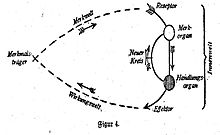Umwelt
| Semiotics |
|---|
| General concepts |
| Fields |
| Methods |
|
| Semioticians |
|
| Related topics |



In the
Discussion
Each functional component of an umwelt has a
As a term, umwelt also unites all the semiotic processes of an organism into a whole. Internally, an organism is the sum of its parts operating in functional circles and, to survive, all the parts must work cooperatively. This is termed the "collective umwelt" which models the organism as a centralised system from the cellular level upward. This requires the semiosis of any one part to be continuously connected to any other semiosis operating within the same organism. If anything disrupts this process, the organism will not operate efficiently.
Uexküll's writings show a specific interest in the various worlds that he believed to exist ('conceptually') from the point of view of the umwelt of different creatures such as
The
"...this eyeless animal finds the way to her watchpoint [at the top of a tall blade of grass] with the help of only its skin’s general sensitivity to light. The approach of her prey becomes apparent to this blind and deaf bandit only through her sense of smell. The odor of butyric acid, which emanates from the sebaceous follicles of all mammals, works on the tick as a signal that causes her to abandon her post (on top of the blade of grass/bush) and fall blindly downward toward her prey. If she is fortunate enough to fall on something warm (which she perceives by means of an organ sensible to a precise temperature) then she has attained her prey, the warm-blooded animal, and thereafter needs only the help of her sense of touch to find the least hairy spot possible and embed herself up to her head in the cutaneous tissue of her prey. She can now slowly suck up a stream of warm blood."[7]
Thus, for the tick, the umwelt is reduced to only three (biosemiotic) carriers of significance: (1) the
Critics
Uexküll's application of the notion of "umwelt" to the human person has been contested. In "Welt und Umwelt"[8] and "Die Wahrheit der Dinge", the philosopher and sociologist Josef Pieper argued that reason allows the human person to live in "Welt" (world) while plants and animals do indeed live in an Umwelt—a notion he traces back far beyond Uexküll to Plato, Aristotle, and Thomas Aquinas.
See also
- Cognized environment – Anthropological concept
- Existential therapy – Form of psychotherapy
- Phenomenology – Philosophical method and schools of philosophy
- Qualia – Instances of subjective experience
- Reality tunnel – Theory of personal perception
- Worldview, also known as Weltanschauung – Fundamental cognitive orientation of an individual or society
References
- ISBN 0-87750-194-7.
- ISBN 978-0-415-44072-1.
- ^ Cobley, Paul (2010). The Routledge Companion to Semiotics. London and New York: Routledge. p. 348.
- S2CID 353246.
- ISBN 0-306-42321-9.
- ^ Uexküll, Jakob von (1957). "A Stroll Through the Worlds of Animals and Men: A Picture Book of Invisible Worlds". In Schiller, Claire H. (ed.). Instinctive Behavior: The Development of a Modern Concept. New York: International Universities Press. pp. 5–.
- S2CID 141790408, archived from the original(PDF) on 2019-10-25
- ^ Joseph Piepers, “Welt und Umwelt,” in Schriften zur Philosophischen Anthropologie und Ethik: Grundstrukturen menschlicher Existenz, 180–206.
Further reading
- Kull, Kalevi (1998). "On Semiosis, Umwelt, and Semiosphere". Semiotica. 120 (3/4): 299–310.
- Naming Nature by Carol Kaesuk Yoon
- Augustin, Prisca (2009). "Translating Jakob von Uexküll — Reframing Umweltlehre as biosemiotics". .
- View from the Oak by Herbert and Judith Kohl The New Press | https://thenewpress.com/books/view-from-oak
- Inside of a Dog: What Dogs See, Smell, and Know by Alexandra Horowitz Scribner | https://www.simonandschuster.com/books/Inside-of-a-Dog/Alexandra-Horowitz/9781416583431
- An Immense World by Ed Yong Penguin books Vintage | https://www.penguin.co.uk/books/440513/an-immense-world-by-yong-ed/9781847926081
External links
- Umwelt by John Deely
- Umwelt and Phenomenology
- Umwelt and semiosphere by Kalevi Kull
- Pragmatism and Umwelt-theory by Alexei Sharov
- TDE-R - A Subjective Biocomputer by Charles Dyer
